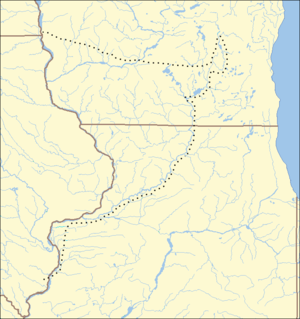Plum River raid
| Plum River raid | |||||||
|---|---|---|---|---|---|---|---|
| Part of the Black Hawk War | |||||||
| |||||||
| Belligerents | |||||||
|
|
Fox | ||||||
| Commanders and leaders | |||||||
| James M. Strode | unknown | ||||||
| Strength | |||||||
| 6; 3 present | unknown; small band | ||||||
| Casualties and losses | |||||||
| 0 | 0 | ||||||
The Plum River raid was a bloodless skirmish that occurred at present-day
Background
As a consequence of an 1804 treaty between the
Prelude
| Map of Black Hawk War sites Symbols are wikilinked to article |
The settlement at the mouth of the Plum River was established in 1827 when copper was discovered near the Mississippi River.[3] When the Black Hawk War erupted in 1832, the settlement at Plum River consisted of 25 people. When the settlers were informed of Black Hawk's invasion they were undecided about whether or not to abandon their homes for safer grounds in Galena, Illinois.[3] In the end, while nearby towns such as Hanover emptied of their residents, the citizens at Plum River decided to send the women and children to Galena and leave the men to stick it out on the frontier.[3] They partially disassembled two of the settlement's homes and constructed a blockhouse for protection. Left to defend the impromptu fortifications were Aaron Pierce, Vance Davidson, Robert Upton, William Blundell, Leonard Goss and a man known as Hays.[3] On May 19 another group of militia volunteers were ambushed at Buffalo Grove and two days later the more famous Indian Creek massacre occurred (on the same day as the raid at Plum River).
Attack
On May 21, 1832, a small raiding party made up of some independent minded braves from
Goss darted inside, but Hays slipped and fell before he could enter the blockhouse. As he fell, three musket balls lodged themselves into the wall where he had been standing moments before. While the attackers reloaded, Hays slipped inside and for about an hour an exchange of heavy gunfire erupted between the parties before the attackers withdrew.[3][5] A fourth man, Upton, was out hunting nearby; when he was discovered by the attackers he was chased throughout the afternoon.[4] Upton escaped the attackers injury-free. In fact, no person was killed or injured during the Plum River raid. The small raiding party escaped with three horses, but two horses were badly wounded by gunfire, and the other shot dead by the settlement's defenders.[4]
Aftermath
The men at the Plum River settlement waited overnight and then fled to Galena where they reported the incident to Colonel
Notes
- ^ a b Lewis, James. "The Black Hawk War of 1832," Abraham Lincoln Digitization Project, Northern Illinois University. Retrieved March 26, 2018.
- ^ "May 14: Black Hawk's Victory at the Battle of Stillman's Run," Historic Diaries: The Black Hawk War, Wisconsin State Historical Society. Retrieved August 6, 2007.
- ^ a b c d e f g h i Carter, Greg. "Plum River Fight 1832," Old Lead Regional Historical Society, 2004. Retrieved August 13, 2007.
- ^ ISBN 0805077588). Retrieved August 13, 2007.
- ^ Drake, Samuel Gardner. Biography and History of the Indians of North America, (Google Books), B. B. Mussey: 1832, 1851, p. 647. Retrieved August 13, 2007.
- ^ "June 1, Dixon's Ferry: "Our difficulties thicken on us daily"," Historic Diaries: The Black Hawk War, Wisconsin State Historical Society. Retrieved August 13, 2007.
42°5′39″N 90°9′23″W / 42.09417°N 90.15639°W

